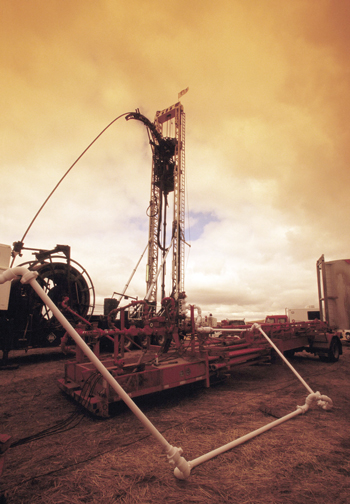FOREWORD
ADVANCES IN COILED TUBING
Coiled tubing equipment and applications are still evolving
RUSSELL WRIGHT, Contributing Editor

Before the Allied invasion of Europe in 1944, British engineers developed and produced very long, continuous pipelines for transporting fuel from England to the Continent to supply the Allied armies. PLUTO (Pipe Lines Under The Ocean) comprised the fabrication and laying of several pipelines across the English Channel. This fabrication and spooling of a continuous flexible pipeline provided the foundation for additional developments that eventually led to the tubing strings and technology that are used today by the coiled tubing (CT) industry.
In 1962, Bowen Tools and California Oil Co. developed a complete CT unit for the purpose of washing out sand bridges in wells. From the late 1960s into the 1970s, equipment continued to improve, ultimately accommodating CT up to 1-in. OD. In the mid-1970s, more than 200 CT units were in service, and by the end of the decade, several new equipment/service companies also started to influence the technology, particularly by improving injector head designs.
The CT industry has been driven by attractive economics, continual advances in technology and its use to perform an ever-growing list of field operations. Today it is a global, multi-billion dollar industry, primarily because its advantages are driven by the fact that a workover rig, and its associated cost, is not required. Also important are rapid CT trip speeds into and out of the well, and that CT operations are designed to be performed with pressure on the well. Eliminating the need to kill the well can be significant in the decision to apply CT for a particular field operation.
In addition to equipment advancements, a larger impact on CT use is the change in the wells in which it is now employed. Wells are deeper and require horizontal extended reach, multilaterals and completions across multiple zones. This has led to a variety of bottomhole assembly (BHA) and technology developments. Annular fracturing is a common application that did not exist a few years ago. A shift to long horizontal wells in very tight reservoirs led to the need for multiple-zone, horizontal well fracturing methods. CT is presently one of the most cost-efficient ways of finishing these wells.
The following selection of articles presents and explains three higher-end CT applications that are newly developed.
Rib-steered motor technology. A new directional CT drilling steering technology is based on the concept of closed-loop steerable drilling systems from rotary drilling applications. The new 3-in, rib-steered motor (RSM) design includes three hydraulically expandable, surface-controlled ribs that generate the required wellbore contact forces that are necessary for drilling complex 3D well profiles. The RSM platform also offers the capability to drill tangents, which is impossible with the combination of bent motors and downhole orienting devices.
Testing of this new platform began in 2008, and it was further improved to become a new standard for horizontal or tangent sections in high-end CTD applications. Compared to bent motor drilling, RSM technology improves weight transfer and enables precise control of weight-on-bit to total depth, allowing for significant extension in lateral section length. It also improves hole quality to make liner running operations more reliable, and reduces non-drilling time by reducing the number of required wiper trips for hole cleaning purposes.
Rotating jetting system cleans sand from low-BHP, large casing deepwater wells. One of the most challenging CT operations is the inside cleaning of a large-diameter casing at a low bottomhole pressure. Often this type work is basic with regards to recovering production, from sanded-up and depleted horizontal wells. When wells are deep, and offshore platform capacity limitations prohibit the use of large size CT, the job’s complexity rises significantly. However, with the integration of several methods such as this special rotating jetting system; real-time fiber-optic downhole (DH) telemetry system; gas lift injection techniques and a new clean-out, shear-thinning, oil-based gel fluid that has superior suspension ability; work that was almost impossible before is now viable. Discussed here are two sand clean-out jobs in Indonesia’s West Seno field—one of which was successful, and the other a failure. 
REFERENCES
1. Sas-Jaworsky II, Alexander, World Oil’s Coiled Tubing Handbook, Gulf Publishing Co., Houston, TX., 1993.
2. An introduction to coiled tubing: History, applications, and benefits, International Coiled Tubing Association, December 14, 2005
3. Newman, Ken, “Where is the coiled tubing wave headed?,” Petroleum Engineer International, September 1994.
4. Portman, Lance, “High-end coiled tubing evolution: The last and next ten years,” 2010-2011 SPE Distinguished Lecturer Series.
|



